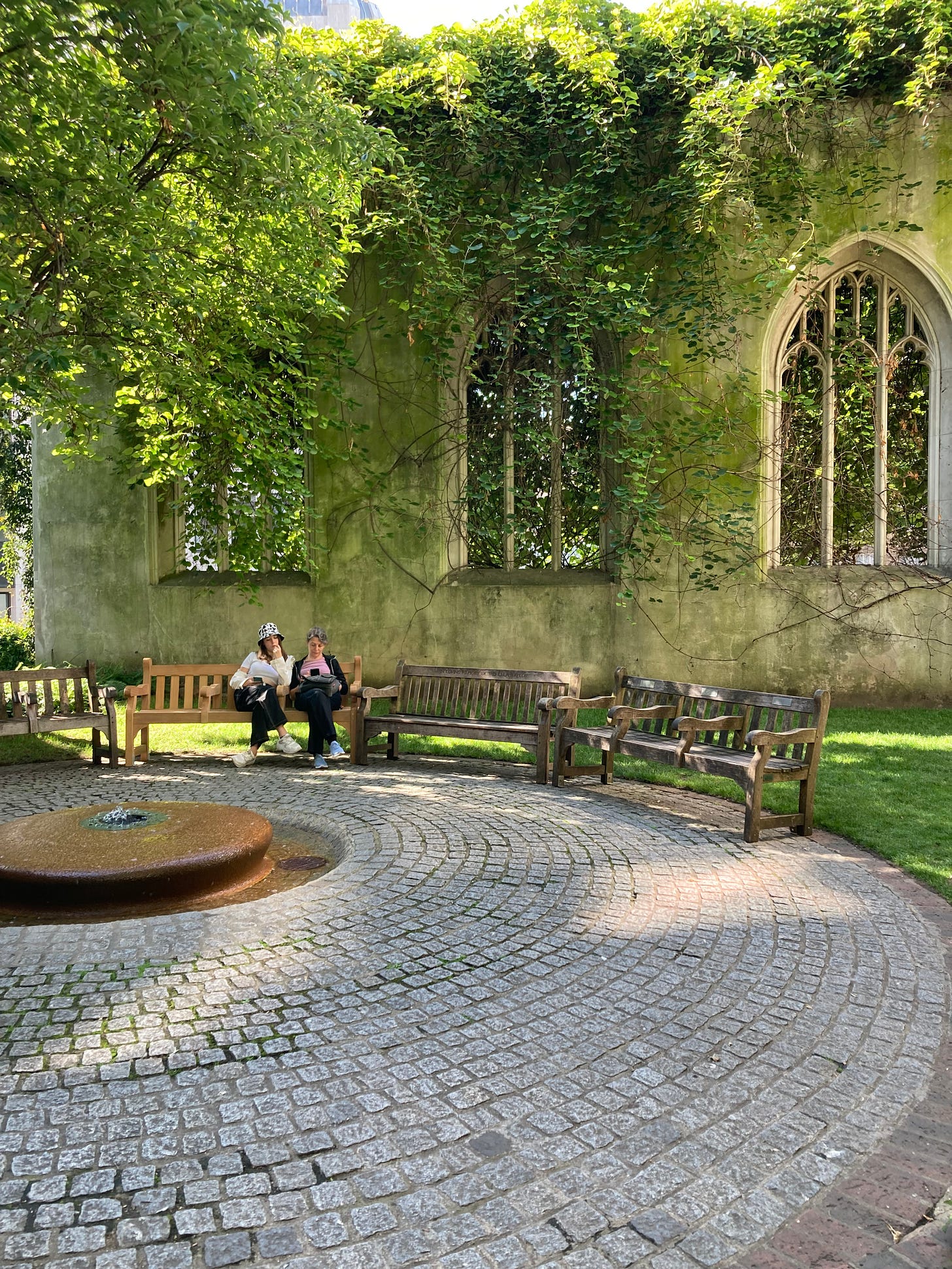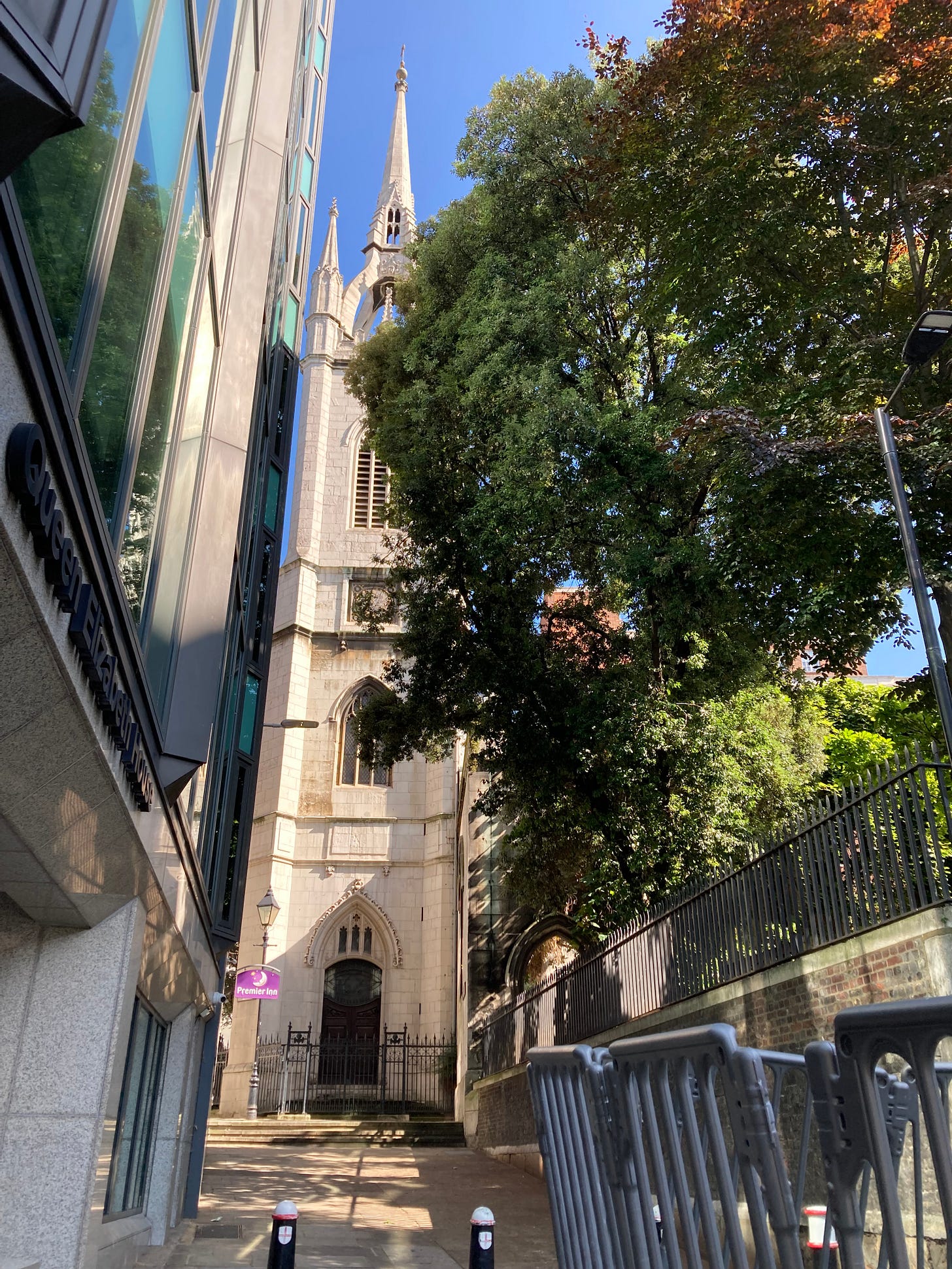A short walk west from All Hallowes one finds the ruins of St. Dunstan-in-the-East. Worship on this site is said to have begun in the 12th century. It may have been part of Barking Abbey like All Hallowes, although I cannot find a definitive answer to that question. The two churches did become associated. The medieval church fell into such disrepair that it received an extensive restoration / refurbishment, finished in 1630, thirty six years before the Great Fire. The flames did not destroy St. Dunstan-in-the-East to such an extent that it required rebuilding. Sir Christopher Wren oversaw the repairs and added a tower and a steeple. It fell into disrepair once again, receiving its final re-build in the 19th century. After the last round of bombings, they called it a day for St. Dunstan-in-the-East. It now remains as a delightful park, crowded in on three sides by modern structures and on the south by a 4-lane road. As far as world financial centers go, this is one of the many reasons why London beats Wall Street and the rest:
Out of all St. Dunstan-in-the-East’s centuries, dear readers, I present two bits of history and some tangentially related poetry. To wit –
On the other side of what is now the 4-lane road lie a “block” or two of buildings and the Thames. The Thames used to flow much closer to this church. The 4-lane road would have been Thames Street, on the other side of which were
divers large landing-places called wharfs or keys, for craneage up of wares and merchandise, as also for shipping of wares from thence to be transported. These wharfs and keys commonly bear the names of their owners, and are therefore changeable . . . in the 26th of Henry VI . . a tenement, called Passeke’s wharf, and another called Horner’s key, in Thames street, were granted to William Harindon, esq.1
The original Billingsgate Market, London’s fish market, was not far from St. Dunstan-in-the-East. Into the 1930s, the church was presented with fish by the nearby merchants and / or the fishmonger’s guild, as was, which became the Worshipful Company of Fishmongers at some point.2
A scandalous outrage occurred in 1417. On 13 April 1417, Easter Day, one Thomas Petwardyn was murdered during an affray inside the church. According to the chronicler Robert Fabyan,
In this yere [1417] also, and vpon the feestfull day of Estr, fyll a chance in Lodon, whiche, to ye fere of all good christen men, is necessary to be noted; for vpon thes high & solempne day, by excytynge of the deuell, & yll disposicion of. ii women, that is to meane the wife3 of the lorde Straunge, & the wife of sir Iohn Trussel knyght, suche vnkyndnesse fyll atwene theyr. ii. Husbandes, the eyther wolde haue slayne other within the parysshe churche of Seynt Dunstannes in the East: in partyng of which persones dyuers men were hurt & wounded, & one named Thomas Petwarden slayne out of hade, whiche was a freeman and fysshemonger of the cytie. Than lastly both frayers were taken & brought vnto the countour in the Pultry, & for the sayd lorde Strauge was demyd culpable of the begynnynge of this fraye, he therefore vpon the Sonday folowyunge, & for suspendynge of the Church, was denounced accursyd at Poulis crosse, & in all parysshe churches of London; and finally he was demyd to open penaunce & dyd it, and made great amendes vnto the wife of the said Thomas for the deth of her husbande: and in the ende of this yere whete at London was solde for. Ii.s. a busshell.4
According to another anonymous 15th-century chronicler of London,
. . . and the same year was Thomas Petwardyn, keeper of Sprottes keye, schlayn in seynt Dunstan Chirche in the Est, in the high chancel, on the Esterday at evesong tyme, with the lord Straunge and his men, and there was Sr. John Trussell and his sone, and othere men of his, sore wounded; and that fray began between the lord Strangeg wife and Sire Trussell wife.5
Lord Richard le Strange of Knockin and his wife, Joan “Constance” Grey were in London at the time, with their “household,” for the purposes of conducting business. Richard’s family at the time owned a vast amount of land including what is now the London Borough of Edgware. Richard’s “open penaunce” would have involved him walking, barefoot, clad only in a shirt, along with his wife and retinue, through London to St. Paul’s Cross (situated then at a place now within St. Paul’s cathedral). Amongst this retinue was Lord Richard’s chaplain, a secular priest named John Audelay. John Audelay would have been at the affray in St. Dunstan-in-the-East and likely a participant.
In 1426, le Strange installed John Audelay as chancel priest in the Augustinian monastery on his lands out toward Wales, the Abbey of Haughmond. He may or may not have taken monastic vows as an Augustinian. I find conflicting views on the matter. In any event, besides praying for the le Strange family, John spent his time writing poetry, all of it on religious themes and all of it staunchly anti-Lollard. He perhaps felt a bit guilty about the goings on in London when he put quill to parchment and wrote this prayer for forgiveness:
Quomodo Jhesus in cruce rogabat Patrem pro inimicis. Oracio.
O Lord Jhesu Crist, hongyng on cros —
Fore our syn I wot hit was —
Ther thou praydist thi Fader alhone
To foregif thyn enmys everechon;
I beseche thee, fore that holé word,
Foregif myn enmys, Y pray thee, Lorde,
That han trespassid here to me,
And grawnt ham love and charyté.
I pray thee, Lord, that hit so be
And that ye wil foregif me.6
Amen.
John died bind. He, unlike many authors of poems in his day, frequently refers to himself in the manuscript. John “the Blind,” therefore, comes during the beginning of the “emergence” of the author in English literature.
He signs off his works as follows:
The furst prest to the Lord Strange he was,
Of thys chauntré, here in this place,
That made this bok by Goddus grace,
Deeff, sick, blynd, as he lay.
Among other works, John Audelay wrote a cycle of 25 Christmas Carols for Advent. These poems, in all their Myddel Englyshnesse, I shall present to you, esteemed readers, each day starting on the first.
Until then, I remain,
Your seasonal Papist,
Peregrinus
Stowe, Survey of London p. 123.
For more alimentary information on London’ churches, please see the fabulous work of Kristin Haakenson here 'Oranges & lemons,' say the bells of St. Clement's and here Clemencing, clemancing, year by year / Apples and pears are very good cheer
The “Trouble & Strife” in the title of this screed is Cockney Rhyming Slang - in honor of St. Dunstan being in the East, although not “the” East End. It means “wife.” It seemed apt in the circumstances.
Other examples of Cockney Rhyming Slang: “Tea leaf” - thief. “Having a butcher’s” = having a “butcher’s hook” = “having a look.” “Ruby Murray” = curry. You get the drift. There are books for those really interested.
Ellis (ed) Fabyan Two Chronichles of England and France, pp. 882 - 583.
A Chronicle of London from 1089 to 1483 written in the 15th century, p. 105.
See “Books” in Reference & Guides under Older English.








Beautiful images!
You must love a city that can display its churches still standing, even as they speak to us 500 years before Henry VIII. How many souls crying out from there!